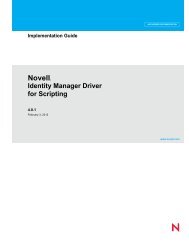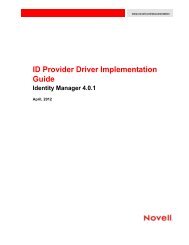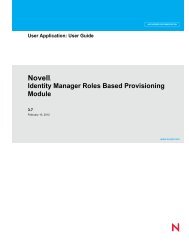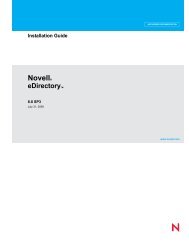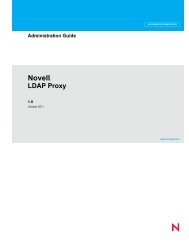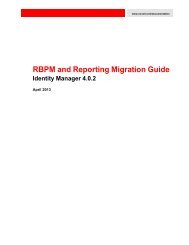Novell iManager 2.7.5 Administration Guide - NetIQ
Novell iManager 2.7.5 Administration Guide - NetIQ
Novell iManager 2.7.5 Administration Guide - NetIQ
Create successful ePaper yourself
Turn your PDF publications into a flip-book with our unique Google optimized e-Paper software.
5.8 Users<br />
Managing users and their network access is a central purpose of the directory. <strong>iManager</strong> provides the<br />
following user‐related tasks:<br />
• Section 5.8.1, “Creating a User,” on page 49<br />
• Section 5.8.2, “Deleting a User,” on page 49<br />
• Section 5.8.3, “Disabling an Account,” on page 50<br />
• Section 5.8.4, “Enabling an Account,” on page 50<br />
• Section 5.8.5, “Modifying a User,” on page 50<br />
• Section 5.8.6, “Moving a User,” on page 50<br />
• Section 5.8.7, “Renaming a User,” on page 50<br />
For more information about user objects in the directory, see the <strong>Novell</strong> eDirectory 8.8 SP7<br />
<strong>Administration</strong> <strong>Guide</strong> (http://www.novell.com/documentation/edir88/edir88/data/a2iii88.html).<br />
5.8.1 Creating a User<br />
To create a new user object:<br />
1 In Roles and Tasks, select User > Create User.<br />
2 In the Create User page provide, at a minimum, the required user‐related information, then click<br />
OK.<br />
• Username<br />
• Last Name<br />
• Context<br />
• Password (twice)<br />
IMPORTANT: If you fail to enter a password, you are prompted to either allow the user to<br />
log in without a password (not recommended) or require a password for login.<br />
Select Set simple password to define a simple password, which is required for native file access for<br />
Windows* and Macintosh* users. It is not necessary when Universal Password is enabled.<br />
Select Copy from template or user object to create a user based on an existing Template or User<br />
object. When copying from a user object, <strong>iManager</strong> allows only a copy of the New Object NDS<br />
rights instead of a copy of NDS rights, to prevent users from receiving the same rights as the<br />
administrator.<br />
Select Create home directory to specify a location for the user’s home directory, which is created<br />
when the user object is created. If you specify a path that doesnʹt exist, a message appears stating<br />
that the userʹs home directory has not been created.<br />
5.8.2 Deleting a User<br />
To delete a user object:<br />
1 In Roles and Tasks, select Users > Delete User.<br />
2 Type the name and context of the object or use the search feature to find it, then click OK.<br />
Roles and Tasks 49




